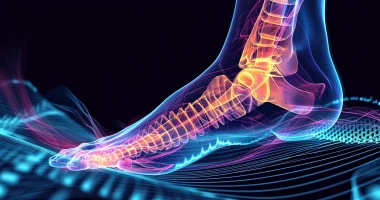Achilles tendon injury
Overview
The Achilles tendon, the strongest and largest in the body, is also the most frequently ruptured. Its rupture incidence has been rising in recent years, influenced by factors like increased life expectancy, growing rates of obesity and overweight, and more active participation in sports. The Achilles tendon is a fibrous tissue band that links the calf muscles to your heel. The strength and flexibility of this tendon are important for jumping, running, and walking. Your Achilles tendon bears a lot of stress and pressure during everyday activities and during athletic and recreational play.
Achilles tendon injuries predominantly occur during sports, accounting for about 90% of cases, with men being 2-12 times more susceptible than women. Most affected are individuals aged 30 to 45 who engage in occasional sports and those aged 60-70, often injured during daily activities. Middle-aged patients typically sustain injuries from sports, whereas older individuals during routine activities.
Causes of an Achilles tendon injury
Different researchers have proposed several theories as to when Achilles tendon injuries occur. Each theory is complementary to the other. There are four main ones: degenerative, mechanical, hyperthermic, and genetic.
Injuries to the Achilles tendon can occur in various forms, including:
Tendonitis: This condition often results from overuse or injury to the area, leading to pain along the back of the leg and around the heel. Tendonitis can cause the tendon to thicken and harden, worsening without treatment. The two primary types are:
- Noninsertional Achilles Tendonitis: Involves small tears in the middle fibers of the tendon, causing pain and swelling, typically affecting active, younger adults.
- Insertional Achilles Tendonitis occurs when the tendon attaches to the heel bone and may include bone spur formation. It can affect people of any age and activity level.
Rupture: A rupture happens when tendon fibers tear partially or completely. It’s often accompanied by a popping sound near the heel or calf, indicating a severe issue that requires immediate medical care.
The main factors leading to rupture include:
- sudden forced plantar flexion of the foot;
- direct trauma;
- overexertion;
- prolonged tendinopathy or internal degenerative changes;
- poor physical preparation before exercise;
- engaging in certain sports (diving, tennis, basketball, athletics);
- prolonged use of corticosteroids;
Risk factors for Achilles tendon injury
Achilles tendon injuries can occur in anyone and are frequently associated with repetitive stress. Key risk factors include:
- Escalating the volume or intensity of physical activity or sports.
- Initiating a new sport.
- Having tight calf muscles at the onset of an exercise or sport increases stress on the tendon.
- The presence of bone spurs on the heel that can irritate the tendon.
- Working out on irregular or uneven surfaces.
- Using inappropriate footwear during exercise.
- Undergoing treatment with the antibiotic fluoroquinolone.
Diagnosis of an Achilles tendon injury
- Diagnosis of Achilles tendon injury is primarily based on careful medical history and physical examination. As a rule, diagnosing a subcutaneous Achilles injury is not difficult.
- Magnetic resonance imaging (MRI) or ultrasound is a significant aid in diagnosis. These studies effectively determine the rupture’s location, the gap between the torn ends of the tendon, and the partial/complete rupture. In the pre-tear stage (tendinopathy, tendonitis), MRI is of significant help.
- Imaging techniques like ultrasound or X-ray are also utilized for diagnosis. An X-ray can reveal bone structures and detect the presence of bone spurs or calcification in the tendon.
Symptoms of an Achilles tendon injury
In acute pathology, symptoms of Achilles tendon injury may be as follows:
- intense pain in the area of the heel and the lower part of the shin;
- cracking sound (a frequent sign of acute Achilles tendon injury);
- soft tissue swelling;
- inability to dorsal flexion;
- inability to rise on toes;
- inability to lift the heel off the floor;
- hypermobility – when attempting to bend the foot toward the rear passively;
- lameness;
The clinical manifestations of chronic Achilles tendon rupture include chronic pain, lameness, and poor or no hindfoot elevation. This condition seriously affects the daily life of these patients.
Achilles tendon injury treatment
The treatment of an Achilles tendon injury may involve either conservative,non-surgical or surgical approaches, depending on the injury’s timing and the tear’s nature. Conservative treatments are typically suitable for less than one-day-old injuries. In contrast, surgical procedures can be applied to recent and older tears. The type of surgery chosen – whether closed, open, or minimally invasive – depends on the specific characteristics of the injury.
Non-surgical treatment
Non-surgical treatment is an option only when the injury occurred within the past day, as any later makes it challenging to effectively reattach the torn ends of the tendon. The typical approach for treating recent tears non-surgically involves immobilizing the affected area in a plantar flexion (equinus) position for 6-8 weeks.
The main benefit of this conservative approach is its non-invasive nature, avoiding complications such as suppuration, skin necrosis, ligature fistulas, or neuritis of subcutaneous nerves. However, there is still a significant risk of tendon re-rupturing; studies indicate that the rate of re-rupture with conservative treatment can be as high as 35%. This method is often more appropriate for less active and older patients, who may face a higher risk of complications from surgery.
The following measures can be taken for managing Achilles tendon injuries:
- Resting the affected area.
- Applying ice to reduce swelling.
- Using nonsteroidal anti-inflammatory drugs (NSAIDs) like ibuprofen or naproxen for pain management.
- Engaging in specific exercises aimed at strengthening the calf muscles.
- Undergoing physical therapy.
- Participating in eccentric strength training to bolster calf muscles and reduce strain on the tendon.
- Opting for low-impact activities such as swimming.
Use heel lifts or orthotic footwear, and sometimes a cast, splint, or walking boot for support.
Surgical treatment
The specific surgical method chosen is contingent on the injury’s location, the extent of damage to the tendon, and other factors like the severity of tendonitis. Various surgical options are available, such as:
- Gastrocnemius recession, a procedure to lengthen the calf muscles.
- Debridement involves removing damaged tendon tissue or bone spurs and repairing the tendon.
- Surgery that entails excising the damaged tendon tissue, repairing the remaining tendon, and reinforcing it by transferring another tendon to the heel bone for additional support.
Achilles tendon surgical treatment is performed in 804 hospitals worldwide (https://doctor.global/results/diseases/achilles-tendon-injury). For example, Achilles tendon repair surgery is done in 20 clinics in Hungary for an approximate price of 2289 USD (https://doctor.global/results/europe/hungary/all-cities/all-specializations/diseases/achilles-tendon-injury).
Prevention of an Achilles tendon injury
Prevention of Achilles tendon rupture is aimed at observing the correct technique of performing sports exercises. This rule is especially relevant for those people who have just started attending the gym. Straightforward advice to reduce the risk of Achilles tendon injury:
- Gradually warm up before engaging in exercise, sports, or repetitive movements.
- Progressively increase your activity levels instead of making sudden changes.
- Choose appropriate footwear for your specific activities.
- Avoid exercising on irregular or uneven surfaces.
- Cease any activities that lead to discomfort or pain.
Achilles tendon injury rehabilitation
Comprehensive rehabilitation is recommended for the best possible recovery of ankle joint function after the main phase of treatment. It usually consists of physical procedures and physical therapy. After the injury, it is recommended to return to sports gradually, increasing the load in a measured manner.
Complications of Achilles tendon injuries
Potential complications arising from an Achilles tendon injury can encompass:
- Intense pain.
- Challenges in walking or engaging in physical activities.
- Deformation in the tendon area or heel bone.
- Risk of tendon rupture due to reinjury.




